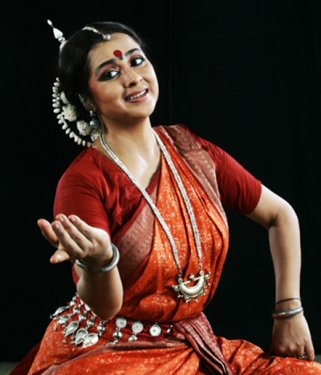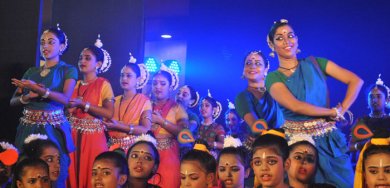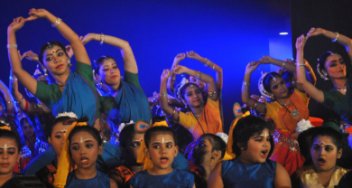
|   |

|   |
The dance we dance: Beginning of a new system of training in Odissi - Dr. Sunil Kothari e-mail: sunilkothari1933@gmail.com May 19, 2014 Disciple of Guru Kelucharan Mohapatra, Sharmila Biswas presented during the annual day of her Odissi Vision and Movement Centre, at Tollygunj Club, Kolkata, a novel presentation which included a new system of training in Odissi. She dedicated the program to Kelubabu, explaining that it was he who laid the foundations on which she stands firmly and spreads her wings. It was very heartening to see this particular program and watch how Sharmila has been devising novel ways of teaching a large number of students ranging from age 4 to 8 for junior section mostly through games in which they learn about movements and space. When the program opened in presence of an overflowing house with parents and dance connoisseurs, several children sitting on dais keeping tala and reciting, one was impressed by the sheer organization of such a large number of students. Sharmila introduced musician Aniruddha Bhattacharya (a disciple of Guru AT Kanan and Malavika Kanan), a junior guru himself, at Kolkata's renowned Sangeet Research Academy, who teaches music to students every Saturday morning. His wide knowledge in classical Indian and Western music helps students to appreciate music from the beginning. Another young person introduced was Srijan Chatterjee, a disciple of Guru Arun Bhaduri. He provides a very crucial support for work on Odissi music for dance.  Sharmila Biswas
Sharmila has divided the curriculum into three sections: (1) Folk dances of Odisha for bringing energy, grace and freedom the students need to be dancers. Also she wants to familiarize them with Odisha's culture, develop Odiya sensibilities and nuances. (2) Odissi dance items. They are simple and complex. Per year each class is taught one such number. (3) Odishi Foundation: It is different from stage repertoire or items. It is devised to strengthen stage performance and generate general awareness. This year Sharmila focussed on Odissi music. She has enlisted support from Bijay Kumar Jena, currently a lecturer at Utkal Sangeet Mahavidyalaya at Bhubaneswar. He is a senior Odissi music scholar, teacher, composer and performer. Sharmila is developing special course in music training for Odissi dance students with his help. The introductory piece titled Dhrupadangik included the text and music composition by Pandit Gopal Panda, with voice over by Bijay Jena. The rhythm composition was by Satchitananda Das.The pedagogy involved practice of movements of eye, neck, chest and upper body movements which helps them to develop control over tala and laya. It also helps them to focus. The bols (the mnemonic syllables) were taken from mridanga artists from Odisha. They form an interesting way to memorise the bols. The warming up exercises with placing arms on waist then to the solfa syllables sa re ga ma pa etc and the exercises sounded interesting. One also noticed the yoga postures with vira bhadrasana, and what we notice in Natyasastra terminology Alidha and Pratyalidha positions with leg firmly planted in front, other leg extended at the back, body balanced firmly and alternating in two directions. Also, extending leg in front holding the toe with fingers. The movements of chest, the pirouettes, bhramaris, with one leg, eka pada, clockwise, and viparita bhramari, anti clockwise; the various feet positions suchi, kunchita, akunchita gharshnita, dhanupada, chauka, ardha chauka, kumbha pada etc were executed well to give an idea of how the various parts of the body and movements of feet etc are practiced. One is familiar with the bols of thai thai ta hat ta thai thai, which Gotipua dancers use and students forming circle seemed to enjoy executing them. The text sukathin kinchite se bahi.. sagat pran sur karu gyan path, karu sugyan kovida, guru gyan param sadhana etc which I could note down seemed to provide students tools to control their movements. The practice of chauka, basic square position, the stamping of feet and movement for three body bends, tribhangi, movement of kati, waist etc appeared quite analytical and intelligent and seemed well conceived to prepare students. The exercises were interspersed with brief dance numbers. The Junior I and II sections presented Raas based on rhythms and poem Natanagar Bansi adhar shobhita, mukha manahar abhijata...and created a festive mood of dance. 

Demonstration of Sthiti was created for this new training programme.The yoga section I referred to earlier was selected by Smita Das. It is of 30 minutes duration, but excerpts only were presented. Samapada, chauka, tribhangi, upper body movements balancing and foot work help students to maintain control over body. To involve students in particular Junior II and intermediate students, a folk dance known as Danda from area of Cuttack is being taught. It makes them feel relaxed and they dance freely. What one saw was that they related to the folk rhythm and it helps to sustain their interest along with practical training in learning Odissi. One interesting number was by two students Sia Mukherjee and Eesha Moitra who presented a composition they created. Many students even if they have been with the institution for long, leave because of Board examinations and cannot attend the class. They finish their exams in March. When they return after that they are encouraged to compose dance by themselves using whatever music they like. Both the students told what they liked and what they did not while learning dance. But it seemed that they did not want to give up. Of course the rigorous hard practice at times bothered them but they knew why it was important to practice. Quite a glimpse into what young dancers feel and wish to express. One abhinaya number taught to intermediate II and IV students optimistically 'to bring blushes in their cheeks' (lajja, shyness) which teenagers now do not know, was a popular song: 'I shall give a garland to Lord Krishna. If he is angry I shall please him by giving betel leaf, if tired will press his feet' and so on. The Odiya song is "Malli mala Shyamku dibi." I think it is OK to teach them. But I do not know if the content of the song will go well with today's young generation's understanding of the devotional aspect it contains. Sharmila works with an NGO institution called Shaili. Her student Lopamudra teaches 30 students there from July 2011. Those students follow Sharmila's curriculum. They also learn Odiya folk dance like Karma and Sambalpuri dance movements but to a Bengal folk song they like to which the students from Shaili school performed. Since the development of a concept of ragas was the starting point of Carmela's course she included swaramalika with demonstration of 10 thaats or Mels in Odissi music. All Odissi ragas are categorized into these 10 thaats. The students learnt 10 thaats and one common Odissi raga from each thaat or Mel; Bijayakumar Jena composed 10 short swaramalikas to explore some of the salient features of Odissi music. The compositions used 7 common talas of Odissi music. The dance compositions were based on all the bhramaris, circular movements in Odissi dance, Nata, Kalyan, Khambaj, Shuddha Deshi, Mukhari, Gauri, Bhairavi, Baradi, Shokh Baradi. The pancham was not demonstrated. The Repertory B group presented Sharmila's choreography Kede Chhanda, an Odiya song featuring Krishna's childhood pranks of killing Bakasura, Putana, subjugating serpent Kaliya and finally when Krishna steals the earth and eats it, Yashoda asks him to open his mouth and sees 'Ashesha Brahmanda,' the universe. The finale was Udam Chandi, a Mayurbhanj Chhau number taught by Trilochan Maharana, in Nataki style, traditionally performed by boys. The term stands in Bengali for a tomboy. The way one after another pair of dancers came forward and danced bumping with each other and running away and return again and again like waves was joyous and concluded the evening with all from tiny tots to elders participating and bringing performance to a climatic close. The next morning, Leela Samson, Madhavi Mudgal, her husband Vinay Jain, students of Sharmila, Nilay and others, and I joined in a discussion to respond to Sharmila's new methodology. It threw light on how Guru Kelucharan Mohapatra was teaching in early years, as a workshop for a month in Cuttack and elsewhere and how Sharmila evolved her curriculum. Observations ranged from showcasing the pedagogy, to rigorous training, changing times, how to sustain their interest, Sharmila trying to let students learn happily and not to have guilt feeling if not achieving perfection but study with fun also and sustain interest. It was interesting to learn about a rigorous practice in Kathakali of learning how to play chenda from waxing moon to waning moon, an amazing time frame, with a set of students, which Leela Samson saw in a Kerala village. That type of rigorous training necessary for Kathakali is now not possible in metropolitan centres. Also, the social background of students, the training methodology in Kathakali differs vastly. But to learn about it was rewarding for us. We all complimented Sharmila for her thinking attitude and evolving this method with the passage of time and engaging students in learning Odissi in Kolkata. As the mantle falls from Guru Kelucharan Mohapatra to Madhavi Mudgal and other disciples of Guruji and Sharmila Biswas, one feels a sense of assurance that Odissi dance is safe in hands of the likes of Sharmila Biswas.  Dr. Sunil Kothari is a dance historian, scholar, author and a renowned dance critic. He is Vice President of World Dance Alliance Asia Pacific India chapter, based in New Delhi. He is honored by the President of India with Padma Shri, Sangeet Natak Akademi award and Senior Critic Award from Dance Critics Association, NYC. He is a regular contributor to www.narthaki.com, the roving critic for monthly magazine Sruti and is a contributing editor of Nartanam for the past 12 years. Post your comments Pl provide your name and email id along with your comment. All appropriate comments posted with name and email id in the blog will also be featured in the site. |